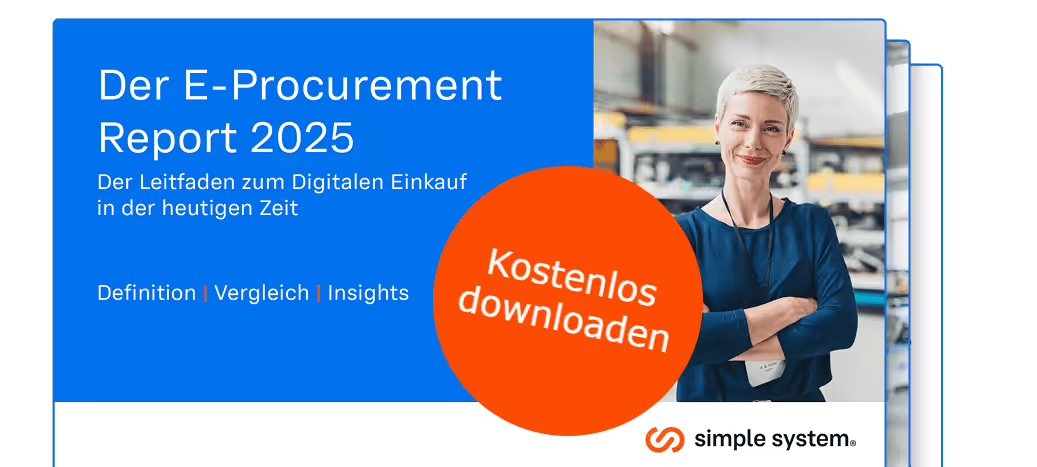The procurement of goods ensures the availability of required materials and forms the basis for efficient business processes. Strategic planning, digitization and sustainability optimize this process, reduce costs, ensure quality and strengthen competitiveness.
The Path to Effective Procurement of Goods — Planned Procurement
The procurement of goods is one of the core functions of any company and plays a decisive role in its overall success.
The availability of required materials, products, and services forms the foundation for smooth production and business operations.
Procurement goes far beyond simply placing orders. It involves a wide range of complex activities — from planning and supplier selection to contract negotiations and quality control.
Strategically planned and well-organized procurement is essential to securing long-term competitive advantages and increasing a company's economic effectiveness.
Definition of Procurement and Its Role in Purchasing
In a business context, procurement refers to the systematic process of acquiring raw materials, semi-finished and finished goods, and services needed for production or service delivery.
The focus is on ensuring availability, quality, and cost-efficiency of these resources.
While the term is also used in the retail sector, there it refers more to the purchase of consumer goods for resale.
Difference Between Procurement of Goods and Other Types of Procurement
Traditional procurement of goods is just one part of a company’s overall procurement activities.
In addition to the physical procurement of materials, there is also:
- Service procurement: e.g. via specialized service providers or external experts
- Indirect procurement: e.g. office supplies, tools, or IT equipment (C-parts), which support operational processes but are not directly part of the production
All of these procurement types play an important role in maintaining the company’s operational performance.
How Does the Procurement Process Work?
While procurement processes can differ depending on the company’s size or industry, they generally follow a similar structure. These phases serve as a guideline to ensure a structured and goal-oriented approach.
Phases of the Procurement Process — Procure-to-Pay (P2P)
The procure-to-pay process consists of several key phases that are fundamental to procurement in companies of all sizes:
- Needs Assessment
Identify the materials, products, or services required. - Supplier Selection and Evaluation
Find and assess potential suppliers based on reliability, quality, and cost. - Quotation Comparison and Negotiation
Evaluate offers and negotiate the best terms. - Ordering and Contracting
Place orders and conclude contractual agreements. - Goods Receipt and Quality Control
Verify deliveries and check for compliance with quality standards. - Invoice Verification and Payment Processing
Match invoices with orders and deliveries, then process payments. - Supplier Management
Maintain and optimize supplier relationships for long-term success.

What are the benefits of efficient procurement of goods?
A tactical and efficient Procurement of products opens up numerous benefits. It helps to reduce costs, optimizes inventory and facilitates long-term, needs-based planning. Key benefits include:
- Cost savings: Through improved negotiating positions and favourable conditions, costs across the entire supply chain can be reduced.
- Improved planning security: Long-term contracts with reliable suppliers improve planning security.
- Increased quality and reliability: Using careful selection processes increase quality and reliability.
- Efficient warehousing: Targeted planning eradicates surpluses and bottlenecks and reduces the space required for storage.
- Better delivery times: Delays in deliveries of goods are eliminated through the strategic purchase of goods.
- Sustainability: Well-organized procurement makes it possible to select environmentally friendly and resource-saving suppliers, which strengthens sustainability and has a positive influence on the corporate image.
- Saving time and simplifying processes: Companies save a lot of time through digitization and automation in the procurement process. With digital platforms and clear processes, orders can be processed faster and more automatically.
How can you optimize the procurement process?
Companies should continuously improve their procurement processes to work more efficiently, reduce costs, and ensure smooth operations.
From building strategic supplier relationships to establishing clear long-term agreements and increasing internal efficiency through smart decisions, there are numerous starting points for optimization that can enhance competitiveness.
Key areas for improvement include:
- Standardizing ordering processes via online platforms
- Digitizing procurement workflows
- Implementing targeted demand planning
Clearly defined contracts help minimize negotiation efforts and create stable, long-term conditions.
Inventory management is also crucial: accurate demand and sales forecasts, combined with the use of safety stocks, help avoid both shortages and excess inventory.
How Simple System Supports Procurement Optimization
The Simple System platform offers digital solutions that make procurement processes significantly more efficient and cost-effective.
It allows companies to centrally manage all procurement activities and provides real-time transparency regarding suppliers, product availability, and order status.
With Simple System, businesses can:
- Standardize procurement processes
- Monitor market trends
- Reduce paperwork
- Track requirements clearly and in real time
- Simplify communication with suppliers
- Manage long-term contracts effectively
This not only accelerates the ordering process but also reduces the risk of errors, contributing to smoother and more reliable procurement operations.
What are the challenges?
The procurement of goods is associated with various challenges that companies must continuously overcome in order to ensure their security of supply and competitiveness. These requirements relate both to product quality and availability as well as the financial and logistical conditions of deliveries. Companies must prepare for potential difficulties in order to react efficiently and maintain operational processes.
Quality assurance of delivered products
A central challenge is quality Assurance of the delivered products. In order to ensure that the delivered goods meet the required standards, it is important to select reliable suppliers and evaluate them regularly. Suppliers can be controlled through audits and the presentation of certificates, so that companies create a good basis for the quality of their materials.
Another decisive factor is the comprehensive Incoming goods inspection, as it ensures that non-compliant products can be identified and rejected at an early stage. Long-lasting partnerships with clear quality agreements support quality consistency and promote trust in the supply chain.

Negotiation of payment terms and conditions
Negotiating payment terms and conditions can be challenging. The main difficulties often lie in a lack of transparency and unclear agreements, which may lead to financial bottlenecks or unexpected liabilities.
Open communication and clearly defined terms help prevent misunderstandings and make payment processes more predictable. By leveraging cash discounts, volume discounts, or early payment incentives, companies can lower procurement costs and improve liquidity. Additionally, it is important to assess the creditworthiness of suppliers regularly to minimize the risk of payment defaults and maintain financial stability throughout the supply chain.
Dealing with supply bottlenecks and delays
The challenge of supply bottlenecks and delays is particularly critical for companies. They disrupt production processes and can cause high follow-up costs. One multi-sourcing strategy, which uses multiple suppliers for critical materials, creates flexibility and reduces risk.
One early needs assessment also helps by preparing for possible bottlenecks and facilitating demand planning. Safety stocks can also be set up to bridge short-term supply bottlenecks. Digital inventory monitoring tools enable predictive planning and ensure that requirements are met in good time. With flexible contracts that include alternative transport routes such as air or rail transport, companies can also react to delays and stabilize the supply chain.
How can you make the procurement of goods sustainable?
A transparent and environmentally friendly procurement process is becoming increasingly important as ecological and social standards are increasingly in focus. Companies can now make their procurement processes more sustainable by using modern technologies and platforms to conserve resources and reduce emissions.

One example of this is the simple system platform, which supports sustainable procurement through digital processes. At simple system, we enable paperless processing and complete transparency along the supply chain. Companies can select environmentally friendly suppliers and materials in a targeted manner, which reduces CO₂ emissions through optimised logistics. Our platform also makes it easier to adjust order quantities to actual demand, which minimizes overproduction and unnecessary transportation. In this way, we promote a more sustainable and efficient purchasing process.
Synopsis
The procurement of goods is a core task in companies, as it ensures the availability of required materials and products — and thus makes a significant contribution to competitiveness. This process goes far beyond simply purchasing goods: it includes selecting and managing supplier relationships, negotiating terms, managing inventory, and ensuring quality standards.
Efficient procurement strategies help reduce costs, prevent supply bottlenecks, and improve operational workflows.
Modern procurement is increasingly shaped by digitalization, traceability, and sustainability. Digital platforms like simple system support companies in managing and automating their procurement processes, increasing transparency across the supply chain, and promoting sustainable decisions that protect the environment and resources.
Companies benefit from:
- Optimized ordering processes
- Clear contract structures
- Flexible strategies that enable quick reactions to market developments
- Long-term stability in procurement
Frequently asked questions
Does sourcing goods strategically help move my business forward?
Yes, because strategic procurement optimizes costs and resources, which contributes to a company's continued competitiveness.
What is the procurement process simplified?
The procurement process comprises the steps from demand planning to ordering to delivery and quality control in a company.
What is procurement — simply explained?
Procurement of goods involves purchasing and managing products and materials that a company needs for its operational processes.
How can the procurement of goods be made fair?
Transparent contracts, fair prices and social responsibility towards suppliers and the environment contribute to fair procurement of goods.
Can procurement processes be simplified with a simple system?
Yes, the platform is used to optimize the entire procurement process and makes it easier to manage, negotiate and process orders.

Einkaufen & sparen
Erfahren Sie, wie es geht, in unserem kostenlosen E-Procurement-Report. Jetzt kostenlos und unverbindlich herunterladen.
Jetzt lesen








